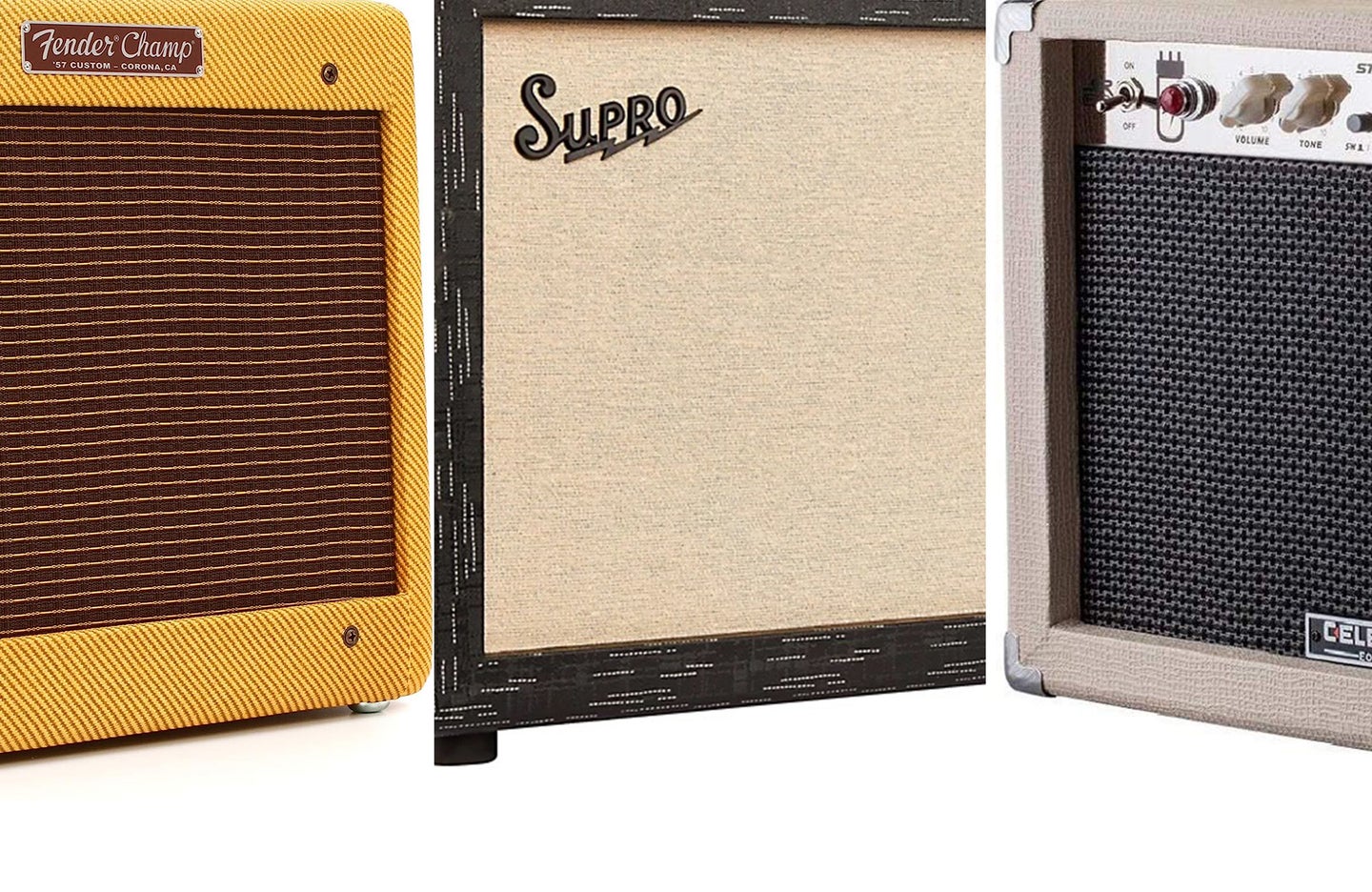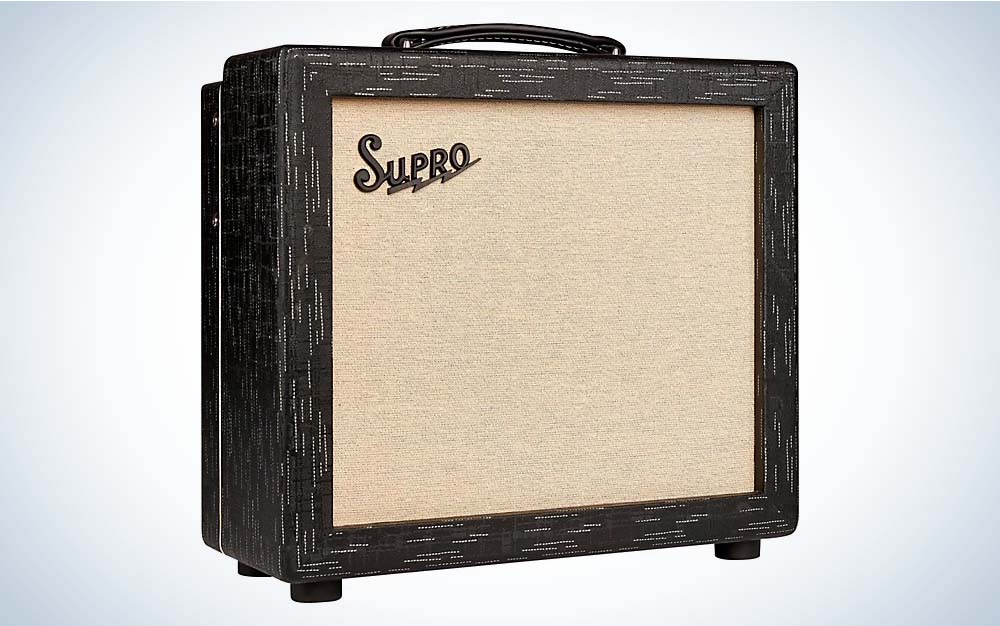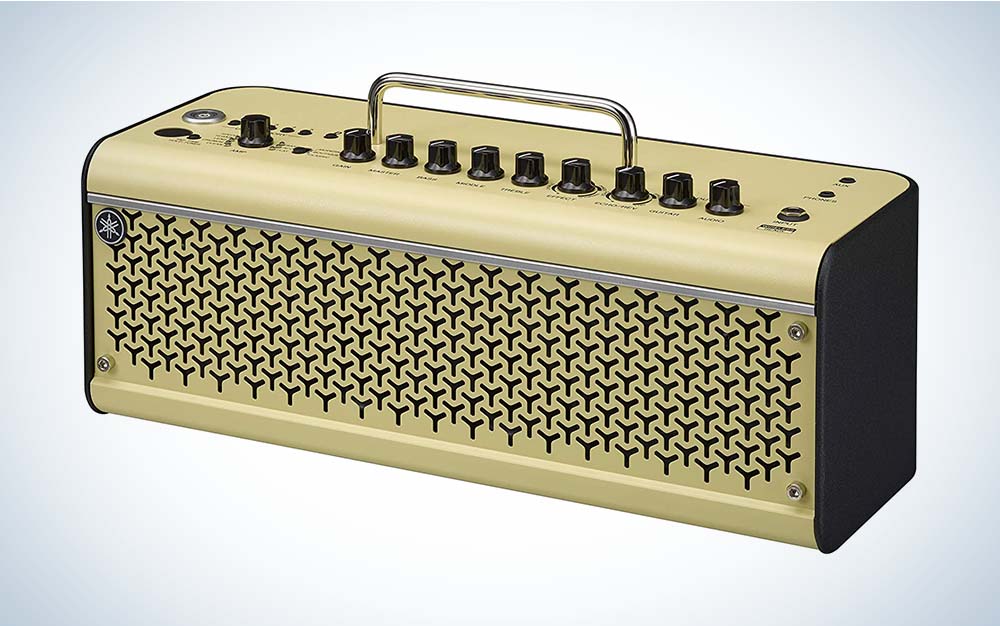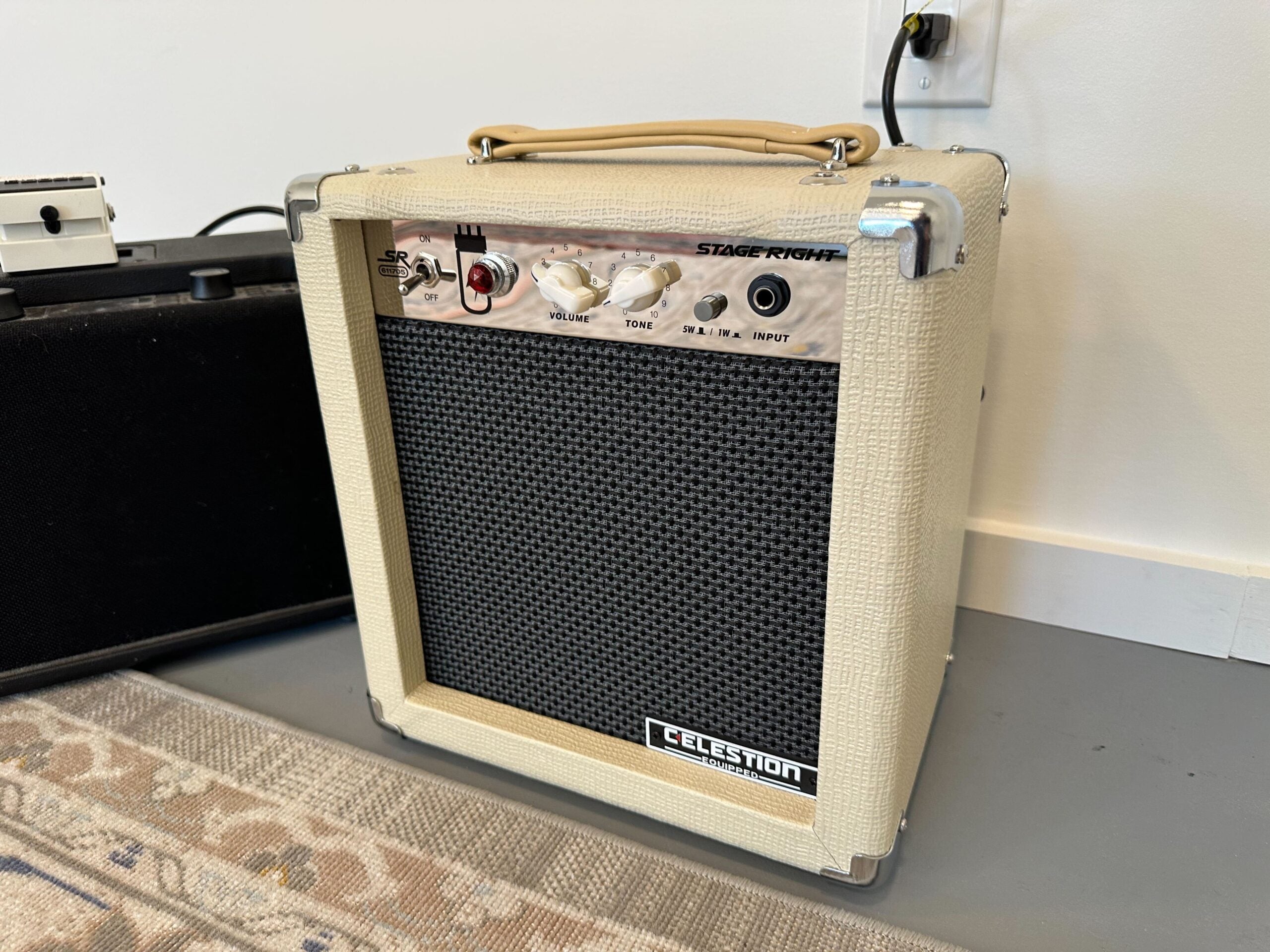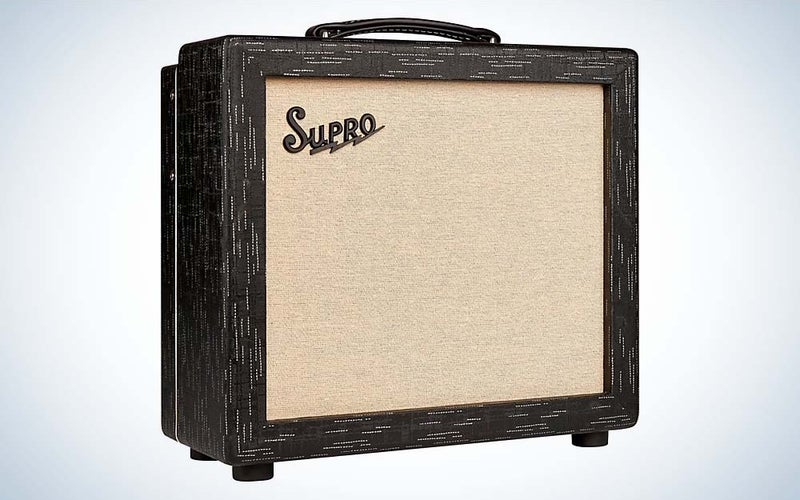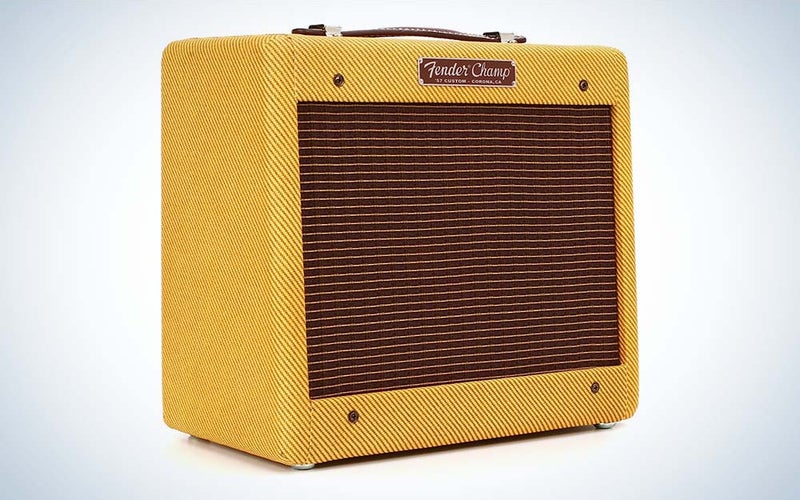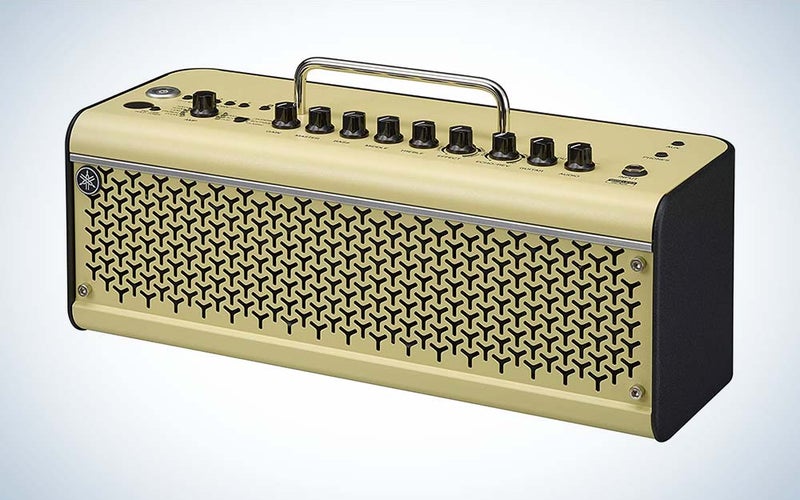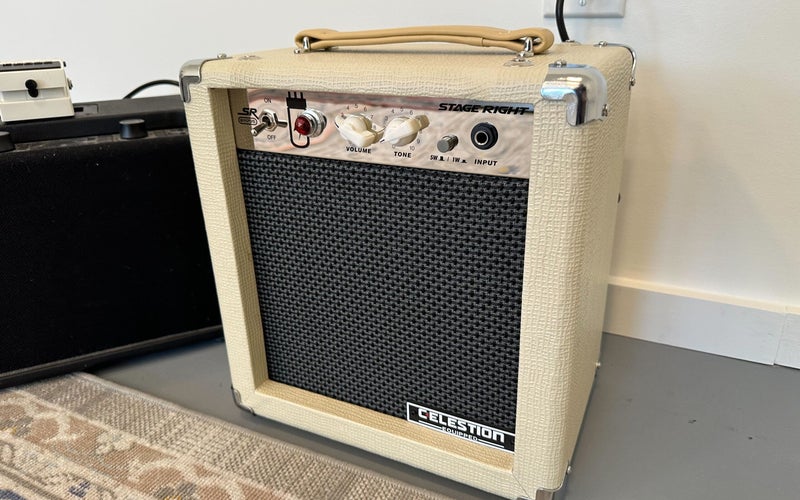We may earn revenue from the products available on this page and participate in affiliate programs. Learn more ›
Whether you’re performing around town, studio-hopping, or just short on free space at home, you don’t have to sacrifice sound quality or style when opting for a small guitar amp. Apart from being inherently compact and portable, small guitar amps have many creative advantages over their larger counterparts due to their ability to produce full-spectrum sound and ear-pleasing overdrive at lower volumes, making them a fantastic first choice for practicing at home or miking up in a studio. In this article, we’ll give you a quick rundown of our favorite mini amps for every task, big and small, to help you decide which of the best small guitar amps is right for your next creative project.
- Best overall: Supro 1612RT Amulet
- Best Fender: Fender ‘57 Custom Champ
- Best for bass: Boss Dual Cube LX
- Best wireless: Yamaha THR30 II Wireless
- Best budget: Monoprice 5-Watt Tube Amplifier
How we chose the best small guitar amps
We built this list of the best small guitar amps based primarily on brand reputation, favoring manufacturers with a long track record of creating high-quality musical instruments like Fender, Supro, Yamaha, and Boss. We placed a secondary emphasis on versatility and sound quality, opting for a combination of tube-based and solid-state amp designs to represent a variety of play styles and creative needs. Amps that include extra features like USB connectivity, headphone jacks, and built-in effects are also represented to account for the large number of musicians looking for a small amp primarily for playing, recording, and composing at home.
The best small guitar amps: Reviews & Recommendations
As guitarists, we know the importance of big tones and the value of small, easily transported gear. Here are our picks for electric guitar amps that overdeliver but don’t force you to overexert yourself to move them around.
Best overall: Supro 1612RT Amulet
Supro
Why it made the cut: The Supro 1612RT Amulet features rich tube tone and switchable wattage in a small and stylish package.
Specs
- Type: Tube
- Power: 15 watts (switchable to 5 watts and 1 watt)
- Speakers: 1 x 10-inch
- Effects: Reverb, vibrato
- Dimensions: 17.5 x 17 x 8 inches (H x W x D)
- Weight: 28.9 pounds
Pros
- Switchable wattage for tube overdrive at any volume
- Built-in tube reverb and tremolo
- Celestion G10 speaker delivers assertive, full-bodied tone
Cons
- Heavier and bulkier than other small tube amps
Suppose you’re looking for a guitar amp that can deliver plenty of volume and authentic tube tone without dominating your space. In that case, the Supro 1612RT Amulet offers a perfect balance of size and tonal versatility in a stylish design that looks great in any room. Featuring a 10-inch Celestion G10 speaker and 2-band EQ, the 1612RT Amulet has a distinct midrange-forward sound that pairs well with effects and stands out in a mix, making it a great choice for studio and stage applications alike. Unlike traditional tube guitar amp designs, the Amulet also includes a unique three-way wattage switch, allowing players to access the amp’s natural tube overdrive at a range of volumes without the need to turn all the way up.
While the Supro 1612RT Amulet’s larger speaker produces ample low-end to deliver its versatile and full-bodied sound, it adds quite a bit of weight and bulk compared to 8-inch speaker designs like the Fender ‘57 Custom Champ. We think this trade-off is more than worth it due to the wider tonal palette of a larger speaker, but this is something to consider if you’re looking to travel frequently with your small guitar amp.
Best Fender: Fender ‘57 Custom Champ
Fender
Why it made the cut: The ‘57 Custom Champ is one of Fender’s smallest tube amps and delivers tons of classic tweed overdrive in a portable configuration.
Specs
- Type: Tube
- Power: 5 watts
- Speakers: 1 x 8-inch
- Effects: N/A
- Dimensions: 12.5 x 13.5 x 7.6 inches (H x W x D)
- Weight: 15 pounds
Pros
- Very lightweight and compact
- Full-throated, versatile, harmonically rich tone
- High-quality handwired construction
Cons
- Pricey
- Quieter than larger amps
- No reverb
If you’re looking for authentic Fender tone in the smallest package possible, the Fender ‘57 Custom Champ packs enough punch and sparkle to satisfy even the most discerning guitarists. With a 5-watt, 15-pound design built around a custom Weber speaker and three tubes, each ‘57 Custom Champ is wired by hand in true vintage fashion, departing from more modern PCB designs. The result is a very responsive and sensitive amplifier that delivers tons of high-end sparkle and full-bodied overdrive across its entire volume range despite its below-average size volume. Though it’s not loud enough to keep up with a full live band, the ‘57 Custom Champ has an advantage over bigger and louder amps in recording and home practice settings due to its ability to produce complex and musical tube overdrive without bothering the neighbors.
While the ‘57 Custom Champ is far and away our favorite small Fender amplifier, its price tag may be out of reach for more casual players who don’t require vintage-spec tone and watertight quality control out of the box. Suppose you’re looking to spend a bit less. In that case, the slightly larger and heavier Fender Pro Junior IV features a very similar sound, design philosophy, and level of responsiveness with a tone profile that leans a bit brighter.
Best for bass: Boss Dual Cube LX
Julian Vittorio
Why it made the cut: The Dual Cube LX is the perfect traveling companion for bassists looking to compose or practice thanks to its built-in effects and battery-powered design.
Specs
- Type: Solid state
- Power: 10 watts
- Speakers: 2 x 5-inch
- Effects: Reverb, chorus, flanger, looper, echo, wah
- Dimensions: 10.3 x 13.4 x 8.1 inches (H x W x D)
- Weight: 9.75 pounds
Pros
- Lightweight design with battery-powered option
- Multiple effects and preamp voicings with onboard looper
- Built-in USB functionality for livestreaming and recording
Cons
- Footswitch sold separately
- Too quiet for playing with bands
- Small speakers sacrifice some low-end volume
“Portable” isn’t the first thing we’d usually associate with a bass amp, but the unique and lightweight Boss Dual Cube LX manages to be just that and a whole lot more. With a huge suite of built-in stompbox-style effects and switchable preamp voicings, the Dual Cube LX is a dream for recording, composing, and practicing on the go. In addition to packing 10 watts of power and dual 5-inch speakers, this tiny bass amp features dual stereo XLR line outputs, a 3.5mm jack, and a dedicated USB output, allowing for direct connection to a wide variety of live sound and recording equipment. While this is all certainly impressive, we were most blown away by the ability to run the Boss Dual Cube LX at full volume using eight AA batteries, which allowed us to test it in remote recording applications with a laptop.
Like all small bass guitar amps, the Boss Dual Cube LX struggles a bit to push the sub-bass frequencies and volume required to hold its own in a live band scenario. Regarding rehearsing, this amp is decidedly best at stripped-down configurations featuring an equally quiet guitar or vocal and no drum kit. While the Boss Dual Cube LX does come with its own AC adapter for wall power, we wished it came with a footswitch to harness the amp’s awesome looper ability right out of the box.
Best wireless: Yamaha THR30 II Wireless
Yamaha
Why it made the cut: The Yamaha THR30 II Wireless features a built-in rechargeable battery, USB connectivity, and several modeling options that make it a powerful and flexible tool for creativity on the go.
Specs
- Type: Solid state
- Power: 30 watts (15 watts battery-powered)
- Speakers: 2 x 3.5-inch
- Effects: Reverb, chorus, tremolo, phaser, echo
- Dimensions: 7.9 x 16.4 x 6.1 inches (H x W x D)
- Weight: 9.5 pounds
Pros
- Models 15 guitar amps, 3 bass amps, and 3 acoustic mics
- Control backing tracks and adjust settings via Bluetooth
- Integrated wireless receiver and built-in rechargeable battery
Cons
- Wireless transmitter sold separately
If you’re looking for an all-in-one amp for playing or recording acoustic, electric, and bass guitar, the Yamaha THR30 II Wireless is a fantastic option with a portable and versatile design that can easily integrate with small spaces and busy lifestyles. Weighing in at just under 10 pounds, the THR30 II Wireless features 21 different amp and mic modeling options to produce a wide range of tones from clean to crunchy alongside an array of classic effects like reverb, chorus, and tremolo. When plugged in, the amp’s 30 watts of power and two 3.5-inch speakers produce ample volume for practicing or performing live in stripped-down musical settings. If you’re hitting the road or playing outdoors, the THR30 II Wireless’s built-in rechargeable battery keeps things humming along at a reduced power of 15 watts.
In addition to its modeling capabilities, the Yamaha THR30 II Wireless features other high-tech functions, including Bluetooth connectivity for streaming backing tracks to the amp, making tone adjustments, and recalling presets directly from your smartphone. A plug-and-play USB connection also allows the amp to function as a recording interface for sending two channels of audio directly to your computer. If you want even more freedom of movement, the amp features a unique built-in wireless receiver for cable-free performance, but you’ll need to pick up the required Line 6 Relay G10TII transmitter unit separately.
Looking to save some cash but still want similar features, including effects modeling, an audio interface, plus Bluetooth speaker functionality? Check out the Positive Grid Spark Mini 10W Smart Amp, a truly portable guitar amp under $500.
Best budget: Monoprice 5-Watt Tube Amplifier
Billy Cadden
Why it made the cut: This small, no-frills amp delivers authentic tube tone at a surprisingly affordable price point.
Specs
- Type: Tube
- Power: 5 watts (switchable to 1 watt)
- Speakers: 1 x 8-inch
- Effects: N/A
- Dimensions: 12 x 12.2 x 8.3 inches (H x W x D)
- Weight: 13.2 pounds
Pros
- Real tube overdrive at an affordable price point
- Switchable wattage offers tonal variation at a range of volumes
- Sturdy, substantial construction
Cons
- Very basic tone controls, no reverb
- Build quality reflects budget price tag
- Not as portable as lighter amps
Things to consider before buying a small guitar amp
Do you require an amp with built-in effects?
If you don’t have guitar pedals or other outboard gear, you may want to consider a guitar amp with built-in effects. Our best overall pick, the Supro 1612RT Amulet, features a combination of built-in tube-powered reverb and tremolo to deliver a range of classic tones. If you’re looking for even more options, consider an amplifier with built-in echo, chorus, and other classic effects like the Yamaha THR30 II Wireless.
Will you be traveling with your small guitar amp?
If you’re traveling or commuting with your small guitar amp, size, and weight are important factors to consider. Generally speaking, solid-state amps are better travel companions due to having lighter circuitry and fewer sensitive components than tube amps, and when considering amp dimensions, any design with an 8-inch speaker should provide a good balance of volume and portability.
Do you have a preference between real tube overdrive and emulation?
Small tube amps have a unique sound all their own thanks to their ability to create rich, warm analog overdrive without the need for extra pedals or effects circuitry. While these designs are highly sought-after by tone purists and often work well with guitar pedals, the best small tube amps generally don’t include any other built-in effects. If you want a little more tonal flexibility, consider a solid-state amplifier like the Yamaha THR30 II Wireless that’s built to model several different types of cabinets and preamps.
FAQs
Q: How much does a small guitar amp cost?
Small guitar amps cost anywhere from around $120 to over $2,000.
Q: Can I use a small guitar amp for live performances?
Yes, you can use a small guitar amp for live performances in small indoor spaces, particularly if you’re not playing with a loud drummer. If you’re playing outdoors or in a venue that requires more volume, it’s common practice to add a microphone to the front of your small amp and send it through the PA system.
Q: Are there any small amps with effects?
There are many small amps with effects, including the Boss Dual Tube LX for guitar and bass, the Yamaha THR30 II Wireless, and the Supro 1612RT Amulet.
Q: Does the size of an amp matter?
The size of an amp rarely matters unless you don’t have the option to amplify it further using a microphone. For example, a small amp placed on stage in a venue can be amplified further using a microphone and a PA system. Additionally, small amps are ideal for recording studios because they can sound rich and full without getting too loud. If you need an amp to fill a space with sound while unassisted by a PA system, then bigger is definitely better.
Final thoughts on the best small guitar amps
- Best overall: Supro 1612RT Amulet
- Best Fender: Fender ‘57 Custom Champ
- Best for bass: Boss Dual Cube LX
- Best wireless: Yamaha THR30 II Wireless
- Best budget: Monoprice 5-Watt Tube Amplifier
Our favorite small guitar amp for stage and studio use is the Supro 1612RT Amulet, thanks to its incredibly rich tone, flexible tube overdrive, and integrated tremolo with reverb. If you’re looking for something a bit smaller, the Fender ‘57 Custom Champ is an equally versatile option sans effects that’s even snappier and more responsive but a bit quieter. For buskers, home recordists, and frequent travelers, we recommend the Yamaha THR30 II Wireless for its minimal weight, wireless capabilities, and built-in battery, while we recommend the solid-state Boss Dual Cube LX for bassists looking for a solid practice amp with a built-in USB interface and effects.
Why trust us
Popular Science started writing about technology more than 150 years ago. There was no such thing as “gadget writing” when we published our first issue in 1872, but if there was, our mission to demystify the world of innovation for everyday readers means we would have been all over it. Here in the present, PopSci is fully committed to helping readers navigate the increasingly intimidating array of devices on the market right now.
Our writers and editors have combined decades of experience covering and reviewing consumer electronics. We each have our own obsessive specialties—from high-end audio to video games to cameras and beyond—but when we’re reviewing devices outside of our immediate wheelhouses, we do our best to seek out trustworthy voices and opinions to help guide people to the very best recommendations. We know we don’t know everything, but we’re excited to live through the analysis paralysis that internet shopping can spur so readers don’t have to.
